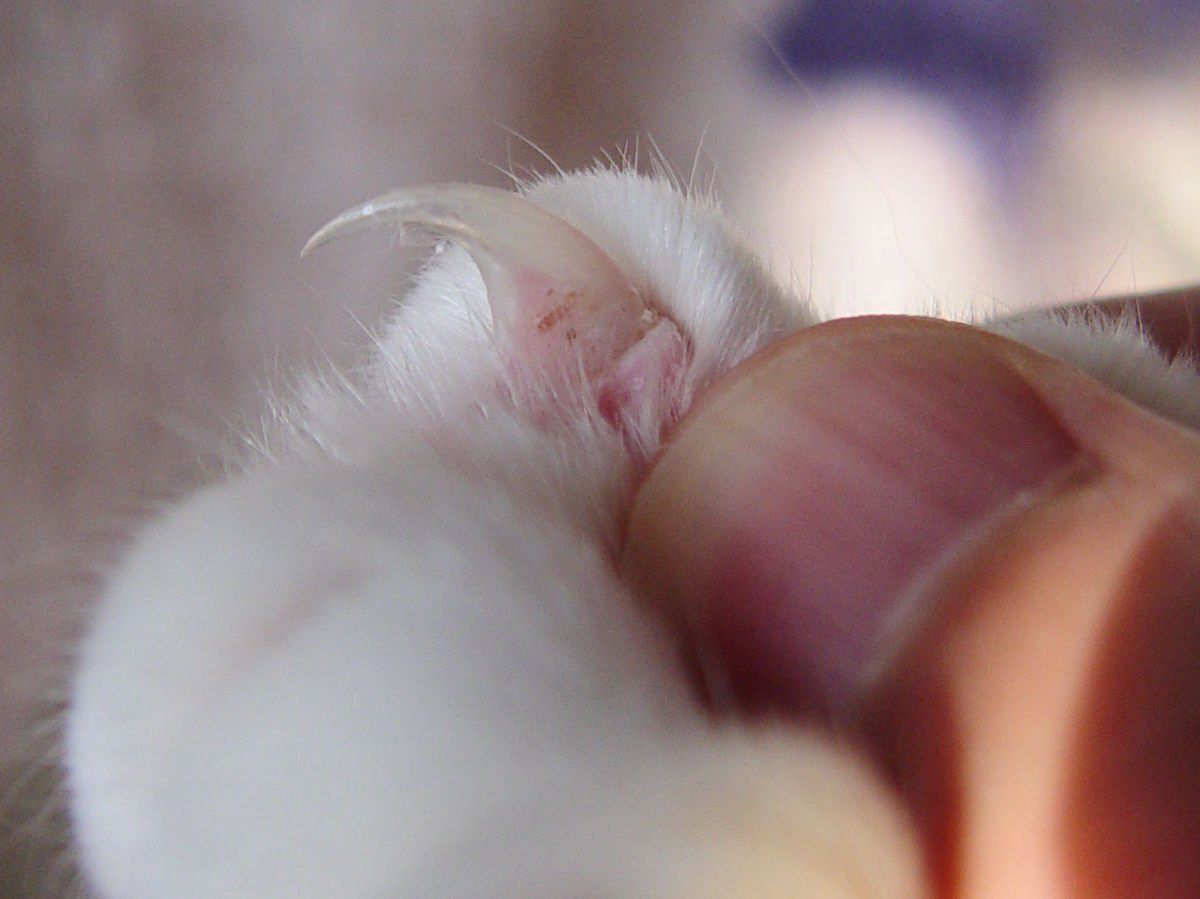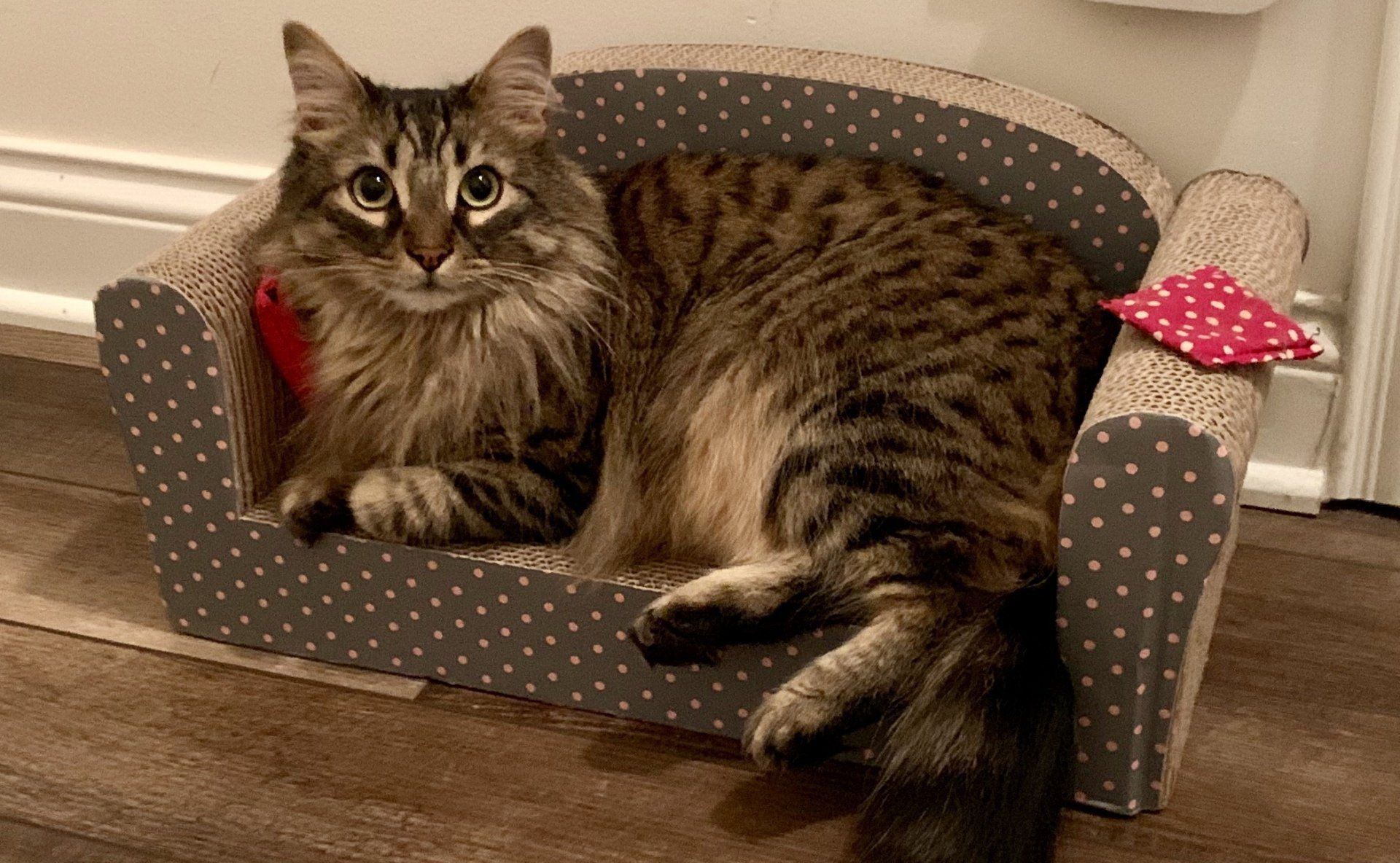Carolyn's Cat Corner

Important Paw Anatomical Information Before we start, it’s really important to understand a little bit about cat paws. Kitty paws are so cute and fascinating. Cats have nails that retract. Refer to image above. By holding the toe between your thumb and forefinger and then pressing down, the nail will extend. This technique helps you stabilize the nail for trimming. The quick is the blood vessel in the center of the nail. In the photo above, you can see the quick as a pink section within the nail body. If your cat has darker nails, the quick won’t be as visible so you will have to cut smaller bits at a time and stop before you reach the quick. It’s a good idea to have a product called Kwik-stop or some other sealant on hand in case you do accidentally cut the quick. This is a powder that is put on the quick to stop the bleeding. Check your cat's nails often. By checking the nails frequently it acclimates your cat to having their paws touched and you can spot any medical problems early. A Few Do’s and Don’ts for cat nail trimming: DO: Get your cat used to having its paws touched without actually trimming the nails. This acclimates your feline to the process and sensation of a nail trim. These sessions should be short at first since cats do not normally like their paws touched. If the response is favorable, no biting or pulling away, a tasty treat can be offered. DO: Start with a relaxed cat and don’t expect to necessarily get all ten nails trimmed in one sitting. It’s common, at least in the beginning, to get a few at a time. Hey...it’s a process and you’re going to get there! DO: Keep the location quiet and small. The less distractions from other cats or humans the better. Go slow during trimming- this is a process and takes time. DO: Use the help of another person to gently restrain and distract the kitty if necessary . Follow the above three tips and use the extra pair of hands to gently wrap the cat in a warm towel to limit movement. DO: Be positive and encouraging of the kitty . Use a soft, high-pitched voice to praise your cat and make this a positive experience. DO: Use sharp nail trimmers and ones you feel most comfortable manipulating. DON’T: Don’t use scissors or human nail trimmers . They can crush a cat’s nail instead of cutting them. Purchase a nail trimmer made for cats at your pet store or favorite online store. DON’T: Don’t get injured! Some cats do best getting their nail trims done by professionals. Cat bites are serious and can quickly get infected. By following the DO’s above, you should already have trust built up with your cat, but still be confident, but cautious! Overall, always remember this is a process that takes time to get comfortable with. If you follow these steps, you’ll foster more confidence in yourself and your kitty to be able to see this process through. It’s often taken our cats several weeks to acclimate, but I was always consistent and went slow during the process and eventually our kitties and I always got to a place where nail trims were no big deal! Kudos to you for trying and kudos to your cat for putting up with the effort!

One of the most challenging and stressful situations for cat owners is getting your cat in a carrier for a veterinary visit. Cats are seen for wellness visits much less frequently than dogs, which is bad news for the overall health of our furry feline friends. So, it’s very important to overcome this obstacle with some practice, empathy, and patience. Cats are creatures of habit and, though they don’t always show it, feel stress when those habits are interrupted. A cat being grabbed out of the blue and shoved into a carrier is very stressful. Add to this a car ride and being poked and prodded at the vet and the association the cat has with the carrier becomes even more negative. So, the goal is to make the carrier experience more habitual, comfortable, and friendly. Take a look at the picture below--that's Merry totally comfortable with his carrier! Such a good boy. :) The following ideas will help your feline become a little more comfortable being transported: Consider purchasing a soft carrier instead of a hard kennel like one. The soft carriers often have better ventilation and also a zippered top where the cat can be gently placed into the carrier.
If possible, leave the carrier out at all times. Our cats have become used to laying in them even when a vet visit isn’t happening! This is ideal because it has become a part of their daily lives!
At a very minimum, bring out the carrier at least two weeks prior to the veterinary visit. The carrier should be made very comfortable and cozy and placed in a quiet spot that entices your cat to hang out in it. A favorite treat can also be placed in the carrier to help your cat have a positive association with it. This works especially well for kitties who are very food motivated. A possible alternative to a carrier is a harness and a leash. It’s very important to acclimate your cat to the harness long before using it for the veterinary visit. Of course, the ideas above take patience, consistency, and time. I could always provide guidance via one of my service offerings to help you and your kitties with this and any other issues you may have. When it comes to getting your cat into a carrier, planning ahead insures a less stressful time for both you and your cat!

So, what do I want with your cat? Short answer: I want to help you improve the relationship you have with your cat. Long answer : Take a deep breath and let's dive in! Here's a little bit about me--the owner of Merry Purrs Consulting--and I hope after reading this it is obvious what I want with your cat! Am an animal lover and, yes, that includes insects and snakes. Sorry, not sorry…. Have had a passion for animals and animal behavior from a young age. Was accepted to nursing school at age 19 and decided I’d rather be a zookeeper. Learned SO much being a zookeeper at Brookfield Zoo for 12 years and completely clicked with so many different kinds of animals, especially Clouded Leopards . Am a proud cat mom of three male cats named Merry, Pip, and the newly adopted Geordie. Bonus fact: Merry is the inspiration for the business name Merry Purrs Consulting after much brain storming with my husband. (See image below for a pic of Merry!) Acquired a vast array of medical and behavioral knowledge after working for 10 years at an all cat clinic. ♥️ dogs too! Just because because I love cats, doesn't exclude me from loving dogs! I had both when I was growing up. Developed the idea for this business after a rough year and it helped me realize how much I have left to offer in this new phase of my career. Have a philosophy of ruling out medical conditions first(!!!!) and then addressing the behavioral concerns. I can definitely provide guidance on seeing a veterinarian when appropriate! Above all , I want my clients to deal with their cats in a positive, interactive, and loving way. Yep, you guessed it, this means no using squirt bottles for bad behavior! If I could only convey to you immediately through this blog how rewarding it is to have a positive relationship with your kitties, I would, but this company is my attempt at doing that for whoever is willing to explore with me! Please click the link on my site to email me if I could help you out with you and your furry friend's relationship!
